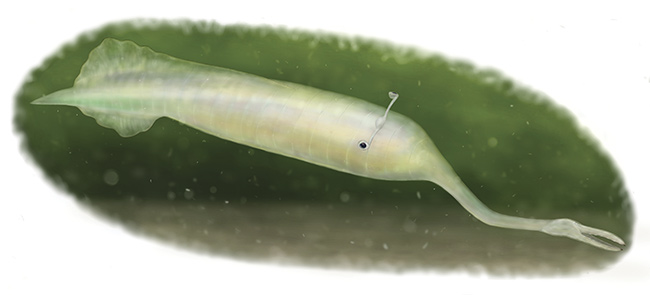
Imaging helps call out a 'monster'
Nearly 70 years ago, an unusual fossil found in Mazon Creek Lagerstätte in Grundy County in Illinois spawned a decades-long dispute about what type of marine creature the Tully monster is. Discovered by fossil hunter Francis Tully in the 1950s, the ~15 cm-long, soft-bodied Tullimonstrum gregarium has stalked eyes and a long nose and is unlike any other species on the fossil record. A debate began among paleontologists in the ensuing years about whether it was properly identified as a vertebrate or invertebrate species, with a slew of published studies articulating both sides of the argument. Modern imaging technology has been used as a mediator.

3D scanning has helped to classify the so-called Tully monster — first discovered in Illinois in the 1950s, it has been a subject of controversy ever since. Courtesy of Takahiro Sakono.
The answer to classifying this find has proved to be about as elusive as establishing where the animal falls in the chain of evolution. This hasn’t stopped scientists in the past from trying to leverage the existence of the Tully monster to advance their own theories about how it fits into that chain, claiming that it could very well be a missing link between invertebrate and vertebrate creatures that lived hundreds of millions of years ago.
Recently, a team of researchers from Japan used both 3D scanning and x-ray microcomputed tomography to determine that the creature was not a vertebrate. The researchers created color-coded depth maps to examine the full structure of the animal and discovered that the Tully monster had segmentation in its head that extended from its body, which is not indicative of vertebrate species. The structure of the nose and tail fins, based on the data provided by these technologies, also did not mirror the anatomical traits of known vertebrates.
The team from the University of Tokyo examined 150 fossilized specimens of the creature as well as dozens of other animals for comparison, with the aid of a 3D scanner called the Artec Space Spider. The images were converted into 3D with the aid of software, which revealed different aspects of the specimens’ anatomical structure on its surface through color variation. Principal component analysis was used to compare similar features that were found in other fossils in the region.
“We scanned other fossils to get clues about the morphology of the Tully monster,” said Tomoyuki Mikami, a doctoral student in the Graduate School of Science at the University of Tokyo who helped lead the research.
Not all of the pieces of the puzzle that were unearthed in the Illinois mud have been placed, including what group within the animal kingdom the Tully monster belongs to. It could potentially be a protostome, a group that includes insects and snails, but finding the category it belongs in is almost as tricky for paleontologists as uncovering and securing the fossils themselves.
Fortunately, for current researchers, the locale of Mazon Creek provided an environment conducive to the preservation of this species that hasn’t been found elsewhere.
“Mazon Creek is a quite rare locality where very soft animals are beautifully preserved as fossils,” said Mikami. “I suspect that in other localities the Tully monster would not be a fossil.”
The publication of the University of Tokyo researchers’ recent observations has not stopped the ongoing contemplation and advancement of theories surrounding these creatures. Much like other mysterious animals that have eluded classification throughout history, the uncertainty and lore surrounding this animal will continue.
Published: September 2023